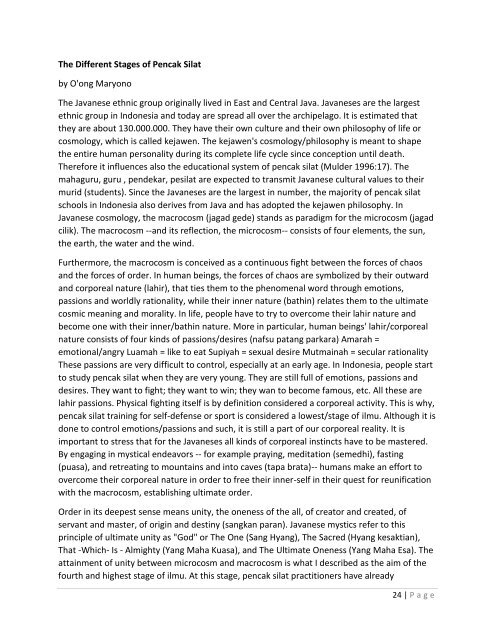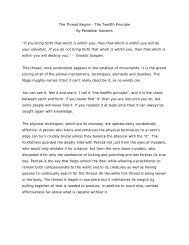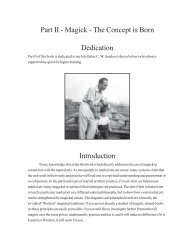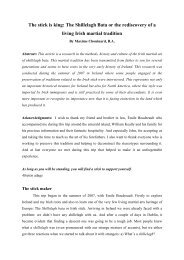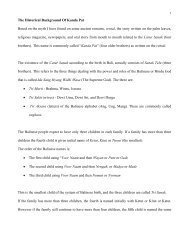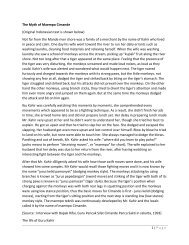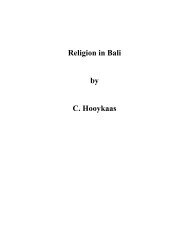Biography of Bapak O'ong Maryono He was born on July 28, 1953 in ...
Biography of Bapak O'ong Maryono He was born on July 28, 1953 in ...
Biography of Bapak O'ong Maryono He was born on July 28, 1953 in ...
You also want an ePaper? Increase the reach of your titles
YUMPU automatically turns print PDFs into web optimized ePapers that Google loves.
The Different Stages <str<strong>on</strong>g>of</str<strong>on</strong>g> Pencak Silat<br />
by <str<strong>on</strong>g>O'<strong>on</strong>g</str<strong>on</strong>g> <str<strong>on</strong>g>Mary<strong>on</strong>o</str<strong>on</strong>g><br />
The Javanese ethnic group orig<strong>in</strong>ally lived <strong>in</strong> East and Central Java. Javaneses are the largest<br />
ethnic group <strong>in</strong> Ind<strong>on</strong>esia and today are spread all over the archipelago. It is estimated that<br />
they are about 130.000.000. They have their own culture and their own philosophy <str<strong>on</strong>g>of</str<strong>on</strong>g> life or<br />
cosmology, which is called kejawen. The kejawen's cosmology/philosophy is meant to shape<br />
the entire human pers<strong>on</strong>ality dur<strong>in</strong>g its complete life cycle s<strong>in</strong>ce c<strong>on</strong>cepti<strong>on</strong> until death.<br />
Therefore it <strong>in</strong>fluences also the educati<strong>on</strong>al system <str<strong>on</strong>g>of</str<strong>on</strong>g> pencak silat (Mulder 1996:17). The<br />
mahaguru, guru , pendekar, pesilat are expected to transmit Javanese cultural values to their<br />
murid (students). S<strong>in</strong>ce the Javaneses are the largest <strong>in</strong> number, the majority <str<strong>on</strong>g>of</str<strong>on</strong>g> pencak silat<br />
schools <strong>in</strong> Ind<strong>on</strong>esia also derives from Java and has adopted the kejawen philosophy. In<br />
Javanese cosmology, the macrocosm (jagad gede) stands as paradigm for the microcosm (jagad<br />
cilik). The macrocosm --and its reflecti<strong>on</strong>, the microcosm-- c<strong>on</strong>sists <str<strong>on</strong>g>of</str<strong>on</strong>g> four elements, the sun,<br />
the earth, the water and the w<strong>in</strong>d.<br />
Furthermore, the macrocosm is c<strong>on</strong>ceived as a c<strong>on</strong>t<strong>in</strong>uous fight between the forces <str<strong>on</strong>g>of</str<strong>on</strong>g> chaos<br />
and the forces <str<strong>on</strong>g>of</str<strong>on</strong>g> order. In human be<strong>in</strong>gs, the forces <str<strong>on</strong>g>of</str<strong>on</strong>g> chaos are symbolized by their outward<br />
and corporeal nature (lahir), that ties them to the phenomenal word through emoti<strong>on</strong>s,<br />
passi<strong>on</strong>s and worldly rati<strong>on</strong>ality, while their <strong>in</strong>ner nature (bath<strong>in</strong>) relates them to the ultimate<br />
cosmic mean<strong>in</strong>g and morality. In life, people have to try to overcome their lahir nature and<br />
become <strong>on</strong>e with their <strong>in</strong>ner/bath<strong>in</strong> nature. More <strong>in</strong> particular, human be<strong>in</strong>gs' lahir/corporeal<br />
nature c<strong>on</strong>sists <str<strong>on</strong>g>of</str<strong>on</strong>g> four k<strong>in</strong>ds <str<strong>on</strong>g>of</str<strong>on</strong>g> passi<strong>on</strong>s/desires (nafsu patang parkara) Amarah =<br />
emoti<strong>on</strong>al/angry Luamah = like to eat Supiyah = sexual desire Mutma<strong>in</strong>ah = secular rati<strong>on</strong>ality<br />
These passi<strong>on</strong>s are very difficult to c<strong>on</strong>trol, especially at an early age. In Ind<strong>on</strong>esia, people start<br />
to study pencak silat when they are very young. They are still full <str<strong>on</strong>g>of</str<strong>on</strong>g> emoti<strong>on</strong>s, passi<strong>on</strong>s and<br />
desires. They want to fight; they want to w<strong>in</strong>; they wan to become famous, etc. All these are<br />
lahir passi<strong>on</strong>s. Physical fight<strong>in</strong>g itself is by def<strong>in</strong>iti<strong>on</strong> c<strong>on</strong>sidered a corporeal activity. This is why,<br />
pencak silat tra<strong>in</strong><strong>in</strong>g for self-defense or sport is c<strong>on</strong>sidered a lowest/stage <str<strong>on</strong>g>of</str<strong>on</strong>g> ilmu. Although it is<br />
d<strong>on</strong>e to c<strong>on</strong>trol emoti<strong>on</strong>s/passi<strong>on</strong>s and such, it is still a part <str<strong>on</strong>g>of</str<strong>on</strong>g> our corporeal reality. It is<br />
important to stress that for the Javaneses all k<strong>in</strong>ds <str<strong>on</strong>g>of</str<strong>on</strong>g> corporeal <strong>in</strong>st<strong>in</strong>cts have to be mastered.<br />
By engag<strong>in</strong>g <strong>in</strong> mystical endeavors -- for example pray<strong>in</strong>g, meditati<strong>on</strong> (semedhi), fast<strong>in</strong>g<br />
(puasa), and retreat<strong>in</strong>g to mounta<strong>in</strong>s and <strong>in</strong>to caves (tapa brata)-- humans make an effort to<br />
overcome their corporeal nature <strong>in</strong> order to free their <strong>in</strong>ner-self <strong>in</strong> their quest for reunificati<strong>on</strong><br />
with the macrocosm, establish<strong>in</strong>g ultimate order.<br />
Order <strong>in</strong> its deepest sense means unity, the <strong>on</strong>eness <str<strong>on</strong>g>of</str<strong>on</strong>g> the all, <str<strong>on</strong>g>of</str<strong>on</strong>g> creator and created, <str<strong>on</strong>g>of</str<strong>on</strong>g><br />
servant and master, <str<strong>on</strong>g>of</str<strong>on</strong>g> orig<strong>in</strong> and dest<strong>in</strong>y (sangkan paran). Javanese mystics refer to this<br />
pr<strong>in</strong>ciple <str<strong>on</strong>g>of</str<strong>on</strong>g> ultimate unity as "God" or The One (Sang Hyang), The Sacred (Hyang kesaktian),<br />
That -Which- Is - Almighty (Yang Maha Kuasa), and The Ultimate Oneness (Yang Maha Esa). The<br />
atta<strong>in</strong>ment <str<strong>on</strong>g>of</str<strong>on</strong>g> unity between microcosm and macrocosm is what I described as the aim <str<strong>on</strong>g>of</str<strong>on</strong>g> the<br />
fourth and highest stage <str<strong>on</strong>g>of</str<strong>on</strong>g> ilmu. At this stage, pencak silat practiti<strong>on</strong>ers have already<br />
24 | P a g e


